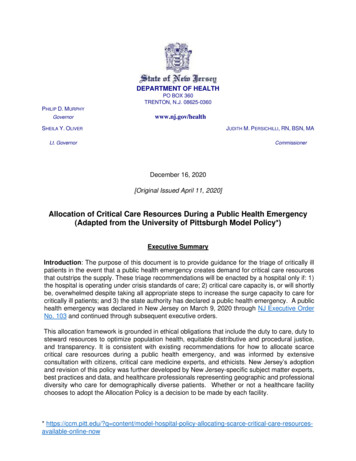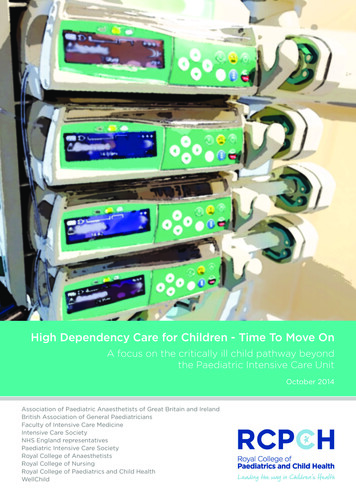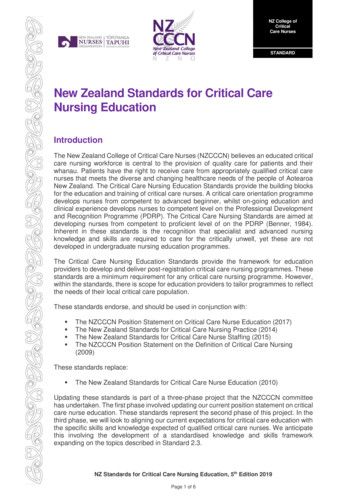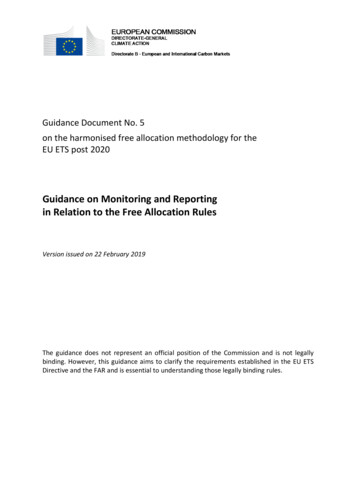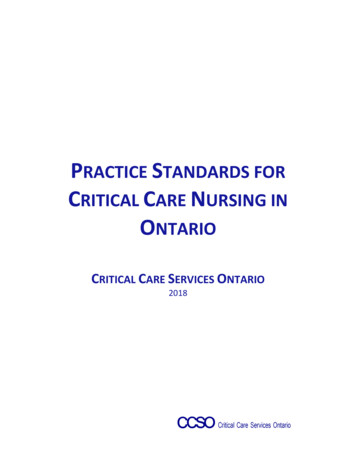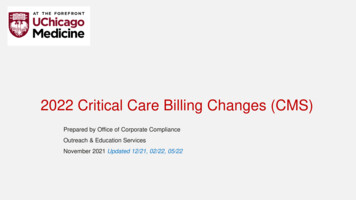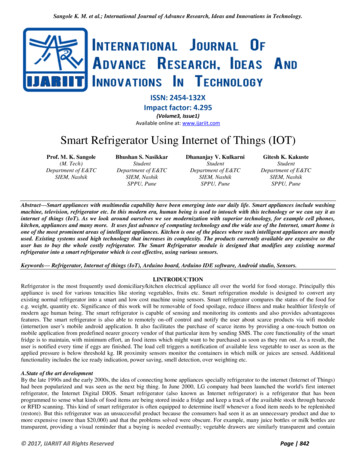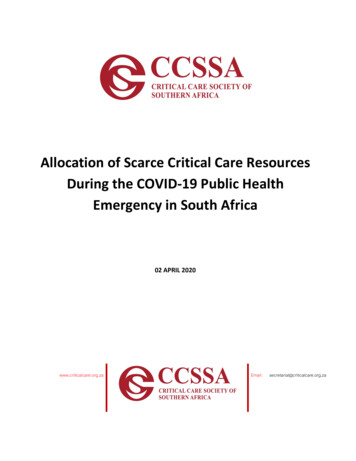
Transcription
Allocation of Scarce Critical Care ResourcesDuring the COVID-19 Public HealthEmergency in South Africa02 APRIL calcare.org.za
Introduction The purpose of this document is to provide guidance for the triage of critically ill patients in the eventthat a public health emergency creates demand for critical care resources (e.g., ventilators, criticalcare beds) that outstrips the supply.These triage recommendations will be enacted only if:1) critical care capacity is, or will shortly be, overwhelmed despite taking all appropriate steps toincrease the surge capacity to care for critically ill patients; and2) His Excellency, the President of South Africa has declared a public health emergency.This allocation framework is grounded in ethical obligations that include:o duty to care,o duty to steward resources to optimize population health,o distributive and procedural justice, ando transparency.It is consistent with existing recommendations for how to allocate scarce critical care resources duringa public health emergency.This document is based largely on The University of Pittsburgh, Pennsylvania guidelines from whomwe have borrowed liberally with permission, with modifications as were deemed necessary.This document describes:I.The creation of triage teams to ensure consistent decision making;II.Allocation criteria for initial allocation of critical care resources; andIII.Reassessment criteria to determine whether ongoing provision of scarce critical careresources are justified for individual patients.2Allocation of Scarce Critical Care Resources During the COVID-19 Public HealthEmergency in South Africa
Section 1. Creation of triage teams The general recommendation in triage processes is that patients’ treating clinicians should not maketriage decisions.The separation of the triage role from the clinical role is intended to promote objectivity, avoidconflicts of commitments, and minimize moral distress.Each hospital will designate an acute care physician triage officer, supported if resources allow by anacute care nurse and administrator, who will apply the allocation framework described in thisdocument.The triage team will use the allocation framework, detailed below, to determine priority scores of allpatients eligible to receive the scarce critical care resource.The triage officer will also be involved in patient or family appeals of triage decisions, and incollaborating with the attending physician to disclose triage decisions to patients and families.An appeals process for individualized triage decisions needs to be in place.***NOTEThe recommendation in terms of formation of triage teams as a formalized process will often bedifficult in many of our settings. There is a limited number of critical care practitioners with therequisite experience to lead such triage teams. An alternate model may need to be sought wheresuitable team leaders and members are not available.In these situations, at an institutional level, any additional practitioners experienced in triage areencouraged to become involved in teams. Where possible, senior members of the critical care teamsare encouraged to take on these roles. Where dedicated triage teams separate from clinicalmanagement teams cannot be formed, it is recommended that triage decisions are not left toindividual managing clinicians, but are rather made by the managing clinical team. Additionally,consultative teams of experienced practitioners covering broader geographical areas may be necessaryto provide an advisory role to local, institutional teams involved in triage.3Allocation of Scarce Critical Care Resources During the COVID-19 Public HealthEmergency in South Africa
Section 2. Allocation process for ICU admission/ventilation Consistent with accepted standards during public health emergencies, the primary goal of theallocation framework is to maximize benefit to populations of patients, specifically by maximizingsurvival to hospital discharge and beyond for as many patients as possible - “doing the greatest goodfor the greatest number.”This goal is different from the traditional focus of medical ethics, which is centered on promoting thewellbeing of individual patients.A triage system will be applied to all patients presenting with critical illness who meet the usualindications for ICU beds, not merely those with the disease or disorders that have caused the publichealth emergency.First responders and bedside clinicians should perform the immediate stabilization of any patient inneed of critical care, as they would under normal circumstances. Along with stabilization, temporaryventilatory support may be offered to allow the triage team to assess the patient for critical resourceallocation. Every effort should be made to complete the initial triage assessment within 90 minutes ofthe recognition of the likely need for critical care resources.Figure 1. A triage (prioritisation) decision is a complex clinical decision made when ICU beds are limited.(Ref. 11)4Allocation of Scarce Critical Care Resources During the COVID-19 Public HealthEmergency in South Africa
The initial assessment of the referred patient focusses on whether the patient is critically ill needingICU admission for either ventilatory support or other organ support only available in ICU. If care, e.g.advanced monitoring is all that is needed, such patients should be managed at appropriate sitesoutside the ICU.Referred patients that are deemed not critically ill enough to be admitted to ICU will need to bemonitored. In the event of a deterioration in their condition, such patients will be re-referred to theICU team.Patients’ wishes in respect of ICU care need to be ascertained. The presence of e.g. advanceddirectives needs to be determined. If there is no clear indication of an expression by the patient toNOT be admitted, further evaluation of priority continues. If there is a clear expression of a wish to nobe admitted to ICU, a further management plan excluding ICU is activated.An assessment is then made of the likelihood of care in the ICU being beneficial. Patients will not beconsidered for admission to critical care beds where further therapy is deemed to be futile. Futility isnot necessarily related to the degree or pattern of acute organ dysfunction, but takes into accountlong term outcome. In general, ICU admission of the following examples of patients would be deemednon-beneficial (futile):§ Brain death in terms of legally defined criteria§ Chronic, terminal and irreversible illness, facing imminent death§ Post cardiac arrest patientso Resulting from a progressive decline in physiological functiono In whom a normal respiratory pattern or full level of consciousness without sedationis not achievedo Fixed dilated pupils not due to medicationo Secondary to a cause that is not reversible§ Irreversible severe brain damage§ Acute, irreversible severe multi-organ failure and anticipated poor prognosisAn assessment of the patient is then made on the Clinical Frailty Scale (CFS) (Figure 2) Patients with aCFS score 6 are to be offered a management plan excluding ICU. Patients with a CFS score 6 areprioritized further.All patients who meet usual medical indications for ICU beds and services will be assigned a priorityscore using a 1-8 scale (lower scores indicate higher likelihood of benefit from critical care), derivedfrom a multi-principle allocation framework (Table 1):1) patients’ likelihood of surviving to hospital discharge, assessed with an objective and validatedmeasure of acute physiology, the Sequential Organ Failure Assessment (SOFA); and2) patients’ likelihood of achieving longer-term survival based on the presence or absence ofcomorbid conditions that may influence survival.5Allocation of Scarce Critical Care Resources During the COVID-19 Public HealthEmergency in South Africa
Figure 2. Clinical Frailty Score. (Ref 9)Table 1. Multi-principle Strategy to Allocate Critical Care/Ventilators During a Public HealthEmergencyPoint System*PrincipleSpecificationSave mostlivesSave most lifeyearsPrognosis for shortterm survivalPrognosis for longterm survival (medicalassessment ofcomorbid conditions)1SOFA score 62SOFA score 6-8Major comorbidconditions withsubstantialimpact on longterm survival3SOFA score 9-114SOFA score 12Severely lifelimitingconditions; deathlikely within 1year#SOFA Sequential Organ Failure Assessment*Scores range from 1-8, and persons with the lowest score would be given the highest priority to receive critical care bedsand services.6Allocation of Scarce Critical Care Resources During the COVID-19 Public HealthEmergency in South Africa
Points are assigned according to the patient’s SOFA score (range from 1 to 4 points) plus the presenceor absence of comorbid conditions (1-4 points) See Table 2 for examples of comorbid conditions.These points are then added together to produce a total priority score, which ranges from 1 to 8.Lower scores indicate higher likelihood of benefiting from critical care, and priority will be given tothose with lower scores.Priority Groupso This raw priority score is converted to three color-coded priority groups (e.g., RED high,ORANGE intermediate, and YELLOW low priority) to facilitate streamlined implementation inindividual hospitals. (Figure 3)o The priority group colour should be noted clearly on the patient chart.o Individuals in the red group have the best chance to benefit from critical care interventionsand should therefore receive priority over all other groups in the face of scarcity.o The orange group has intermediate priority and should receive critical care resources if thereare available resources after all patients in the red group have been allocated critical careresources.o The yellow group has lowest priority and should receive critical care resources if there areavailable resources after all patients in the red and orange groups have been allocated criticalcare resources.Table 2. Examples of Major Comorbidities and Severely Life Limiting Comorbidities*Examples of Major comorbidities (associated withsignificantly decreased long-term survival) Moderate Alzheimer’s disease or relateddementia Malignancy with a 10 year expected survival New York Heart Association Class III heartfailure Moderately severe chronic lung disease (e.g.,COPD, IPF) End-stage renal disease in patients 75 Severe multi-vessel CAD Cirrhosis with history of decompensationExamples of Severely Life Limiting Comorbidities(commonly associated with survival 1 year) Severe Alzheimer’s disease or related dementia Cancer being treated with only palliativeinterventions (including palliative chemotherapyor radiation) New York Heart Association Class IV heart failureplus evidence of frailty Severe chronic lung disease plus evidence offrailty Cirrhosis with MELD score 20, ineligible fortransplant End-stage renal disease in patients older than 75*This Table only provides examples. All patients will be eligible to receive critical care beds and services regardless of their priority score,but available critical care resources will be allocated according to priority score, such that theavailability of these services will determine how many patients will receive critical care.7Allocation of Scarce Critical Care Resources During the COVID-19 Public HealthEmergency in South Africa
ORANGEYELLOWPriority Score 1-3Highest priority forventilatorPriority Score 4-5Intermediate priority forventilatorPriority Score 6-8Lowest priority forventilatorReceive priority over allother groups in face ofscarce resourcesReceive resources ifavailable after all patients inred group allocatedREDReceive resources ifavailable after all patients inred & orange groupsallocatedFigure 3. Assigning Patients to Color-coded Priority Groups In the event that there are ties between patients within the same priority groups, factors below needto be considered in the following order:o Life-cycle considerations with priority going to younger patients, who have had lessopportunity to live through life’s stages. We recommend the following categories: age 12-40,age 41-60; age 61-75; older than age 75.The ethical justification for incorporating the life-cycle principle is that it is a valuable goal togive individuals equal opportunity to pass through the stages of life—childhood, youngadulthood, middle age, and old age.7 The justification for this principle does not rely onconsiderations of one’s intrinsic worth or social utility. Rather, younger individuals receivepriority because they have had the least opportunity to live through life’s stages. Evidencesuggests that, when individuals are asked to consider situations of absolute scarcity of lifesustaining resources, most believe younger patients should be prioritized over older ones.o Individuals who perform tasks that are vital to the public health response – specifically, thosewhose work supports the provision of acute care to others – will also be given heightenedpriority.This category should be broadly construed to include those individuals who play a critical rolein the chain of treating patients and maintaining societal order.o Actual raw priority score from above (1-8) with priority going to the patient with the lowerraw score. Appropriate clinical care of patients who cannot receive critical care.Patients who are triaged to not receive ICU beds or services will be offered medical care includingintensive symptom management and psychosocial support. They should be reassessed daily todetermine if changes in resource availability or their clinical status warrant provision of critical careservices. Where available, specialist palliative care teams will provide additional support andconsultation. Families need to be involved from an early stage.8Allocation of Scarce Critical Care Resources During the COVID-19 Public HealthEmergency in South Africa
During a public health emergency, clinicians should still make clinical judgments about theappropriateness of critical care using the same criteria they use during normal clinical practice. Make daily determinations of how many priority groups can receive the scarce resource.Regular (daily or twice daily) determinations to be made about what priority scores will result inaccess to critical care services. These determinations should be based on real-time knowledge of thedegree of scarcity of the critical care resources, as well as information about the predicted volumeof new cases that will be presenting for care over the near-term (several days). For example, if thereis clear evidence that there is imminent shortage of critical care resources (i.e., few ventilatorsavailable and large numbers of new patients daily), only patients with the highest priority (lowestscores, e.g., 1-3) should receive scarce critical care resources. As scarcity subsides, patients withprogressively lower priority (higher scores) should have access to critical care interventions.9Allocation of Scarce Critical Care Resources During the COVID-19 Public HealthEmergency in South Africa
Reassessment for ongoing provision of critical care/ventilation The ethical justification for such reassessment is that, in a public health emergency when there arenot enough critical care resources for all, the goal of maximizing population outcomes would bejeopardized if patients who were determined to be unlikely to survive were allowed indefinite use ofscarce critical care services. In addition, periodic reassessments lessen the chance that arbitraryconsiderations, such as when an individual develops critical illness, unduly affect patients’ access totreatment.The triage team will conduct periodic reassessments of all patients receiving critical care servicesduring times of crisis (i.e., not merely those initially triaged under the crisis standards).The timing of reassessments should be based on evolving understanding of typical disease trajectoriesand of the severity of the crisis. It is recommended this occurs at 48 hours as a formality andthereafter every 24 hours.A multidimensional assessment should be used to quantify changes in patients’ conditions, such asrecalculation of severity of illness scores, appraisal of new complications, and treating clinicians’ input.Patients showing improvement will continue to receive critical care services until the next assessment.If there are patients in the queue for critical care services, then patients who upon reassessment showsubstantial clinical deterioration as evidenced by worsening SOFA scores or overall clinical judgmentand that portends a very low chance for survival, should have critical care withdrawn, includingdiscontinuation of mechanical ventilation, after this decision is disclosed the patient and/or family.Appropriate clinical care of patients who cannot receive critical care.Patients who are no longer eligible for critical care treatment should receive medical care includingintensive symptom management and psychosocial support. Where available, specialist palliativecare teams will be available for consultation. Where palliative care specialists are not available, thetreating clinical teams should provide primary palliative care. Families are to be intimately involvedin these processes.Special Acknowledgment:Writing Team CCSSA EXCO (Dean Gopalan, Ivan Joubert, Fathima Paruk, Brian Levy)Critical Care Teams from around South Africa for inputScott Halpern & Doug White - University of Pittsburgh, Pennsylvania on whose original document much of this guideline is based.10Allocation of Scarce Critical Care Resources During the COVID-19 Public HealthEmergency in South Africa
References1.Halpern S, White D. Allocation of Scarce Critical Care Resources During a Public Health Emergency. UnivPittsburgh, Pennsylvania. 23 March 20202. Childress JF, Faden RR, Gaare RD, et al. Public health ethics: mapping the terrain. J Law Med Ethics2002;30:170-83. Gostin L. Public health strategies for pandemic influenza: ethics and the law. Jama 2006;295:1700-4.4. Beauchamp TL, Childress JF. Principles of Biomedical Ethics. 6th ed. ed. New York, NY: Oxford UniversityPress; 20095. White DB, Katz MH, Luce JM, Lo B. Who should receive life support during a public health emergency?Using ethical principles to improve allocation decisions. Ann Intern Med 2009;150:132-8.6. Young MJ, Brown SE, Truog RD, Halpern SD. Rationing in the intensive care unit: to disclose or disguise?Crit Care Med 2012;40:261-6.7. Emanuel EJ, Wertheimer A. Public health. Who should get influenza vaccine when not all can? Science2006;312:854-5.8. COVID-19 rapid guideline: critical care. NICE guideline. 20 March 2020. www.nice.org.uk/guidance/ng1599. Rockwood K, et al. CMAJ. 2005;173:489-495.10. Emanuel EJ, Persad G, Upshur R, et al. Fair Allocation of Scarce Medical Resources in the Time of Covid-19.NEJM. 2020. DOI: 10.1056/NEJMsb200511411. COVID-19 pandemic: triage for intensive-care treatment under resource scarcity. Swiss Med Wkly.2020;150:w20229. doi:10.4414/smw.2020.2022912. Joynt GM; Gopalan PD; Argent A; et al. The Critical Care Society of Southern Africa Consensus Statementand Guideline on ICU Triage and Rationing (ConICTri). Joint publication. S Afr J Crit Care. 2019;35(1):36-65and S Afr Med J 2019;109(8):613-642.11Allocation of Scarce Critical Care Resources During the COVID-19 Public HealthEmergency in South Africa
Allocation of Scarce Critical Care Resources During theCOVID-19 Public Health Emergency in South AfricaReferral of any patient to ICU (COVID-19 non-COVID-19)RE-REFERDETERIORATIONManagement Plan excl. ICUDoes the patient need to be admitted?e.g. Isolation COVID-19 ward.Advise on O2 Rx, IPC.e.g.non-COVID-19 patient inHCU/wardNOCritically ill needing ventilatory support/other organ support only in ICU?YESHas the patient expressed wish NOT to be admitted to ICU?YESManagement Planexcluding ICUNOe.g. Isolation COVID-19 ward.Advise on O2 Rx, IPC.NOIs the patient likely to benefit from being admitted to ICU?No ResponseorWorseninge.g.non-COVID-19 patient inHCU/wardYESDiscuss end-of-life issues withnext-of-kinFrailty Assessment ScaleSCORE 6Assess function 1-2 weeks prior to presentationEnd-of-life care(palliative care teams toprovide additional support &consultation)SCORE 6Calculate Priority Score( SOFA Co-morbidity)PrincipleSpecificationSave mostlivesSave most lifeyearsPrognosis for shortterm survivalPrognosis for longterm survival (medicalassessment ofcomorbid conditions)1SOFA score 62SOFA score 6-8Improvement in clinicalstatusand/orresource availabilityRECLASSIFYPoint System*3SOFA score 9-11Major comorbidconditions withsubstantialimpact on longterm survival4SOFA score 12Severely lifelimitingconditions; deathlikely within 1yearReassess daily for changesin resource availability orclinical statusNo ResponseorWorseningSOFA – Sequential Organ Failure Assessm ent* Add points for SOFA category to points for Co-m orbidity category. Point score between 1-8REDORANGEPriority Score 1-3Highest priority forventilatorPriority Score 4-5Intermediate priority forventilatorReceive priority over allother groups in face ofscarce resourcesReceive resources ifavailable after all patients inred group allocatedTransfer to AppropriateSiteYELLOWPriority Score 6-8Lowest priority forventilatorReceive resources ifavailable after all patients inred & orange groupsallocated Management Planexcl. ICU If there are ties within the same colour group, rank as follows:1.2.3. Patient age groups (years) in following order: 12-40; 41-60; 61-75; 75.Individuals whose work supports provision of acute care to othersLower raw priority score from above (1-8)Admit referrals sequentially from red to orange to yellow groups.- Determinations daily of what priority scores will result in access to ventilators/beds- Based on real-time knowledge of degree of scarcity of resources & prediction of volume of newcases over near-termPatients in non-COVID-19 ICUsCOVID-19 patients inIsolation wardNon-COVID-19 patients inhigh care/other siteMedical care incl.intensive symptommanagementAdvise on O2 Rx, IPCPsychosocial support.Discuss end-of-life issueswith next-of-kinPatients triaged to notreceive ICU bed/ventilationPatients in COVID-19 ICUAssess all patients admitted to ICU at 48 hours- Quantify changes in patients’ conditions- Reclassify as per: i) recalculated SOFA scores; ii) new complications & iii) treating clinicians’ inputREDORANGEYELLOWHighest priority forventilatorIntermediate priority forventilatorLowest priority forventilatorPatients with substantialclinical deterioration &very low chance forsurvivalDiscussion amongst teamand then with next-of-kinCritical care to bediscontinuedEnd-of-life care(palliative care teams toprovide additional support &consultation)Subsequently assess all patients admitted to ICU at least every 24 hours- Quantify changes in patients’ conditions- Reclassify as per: i) recalculated SOFA scores; ii) new complications & iii) treating clinicians’ inputREDORANGEYELLOWHighest priority forventilatorIntermediate priority forventilatorLowest priority forventilatorReferences:- Halpern S, White D. Allocation of Scarce Critical Care Resources During a Public Health Emergency. Univ Pittsburgh, Pennsylvania. 23 March 2020- COVID-19 rapid guideline: critical care. NICE guideline. 20 March 2020. www.nice.org.uk/guidance/ng159- Emanuel EJ, Persad G, Upshur R, et al. Fair Allocation of Scarce Medical Resources in the Time of Covid-19. NEJM. 2020. DOI: 10.1056/NEJMsb2005114- COVID-19 pandemic: triage for intensive-care treatment under resource scarcity. Swiss Med Wkly. 2020;150:w20229. doi:10.4414/smw.2020.20229- Joynt GM; Gopalan PD; Argent A; et al. The Critical Care Society of Southern Africa Consensus Statement and Guideline on ICU Triage and Rationing (ConICTri). S Afr J CritCare. 2019;35(1):36-65 and S Afr Med J 2019;109(8):613-642.www.postersession.com
Allocation of Scarce Critical Care Resources During theCOVID-19 Public Health Emergency in South AfricaTABLE. Examples of comorbidities to be used for Priority ScoringExamples of Major comorbiditiesExamples of Severely Life Limiting Comorbidities(associated with significantly decreased long-term survival) Moderate Alzheimer’s disease or related dementiaMalignancy with a 10 year expected survivalNew York Heart Association Class III heart failureModerately severe chronic lung disease (e.g., COPD, IPF)End-stage renal disease in patients 75Severe multi-vessel CADCirrhosis with history of decompensationCurrent AIDS defining illness (or viral load 10000copies/ml despite Rx or recent HIV diagnosis not on Rxwith CD4 50)(commonly associated with survival 1 year) Severe Alzheimer’s disease or related dementiaCancer being treated with only palliative interventions(including palliative chemotherapy or radiation)New York Heart Association Class IV heart failure plusevidence of frailtySevere chronic lung disease plus evidence of frailtyCirrhosis with MELD score 20, ineligible for transplantEnd-stage renal disease in patients older than 75Vincent JL, Moreno R, Takala J, et al. The SOFA (Sepsis-related Organ Failure Assessment) score to describe organ dysfunction/failure. On behalf of the Working Group on Sepsis-Related Problems of theEuropean Society of Intensive Care Medicine. Intensive Care Med. 1996 Jul;22(7):707-10.Note: In the absence of measured blood values for parameters needed for the SOFA score, it is suggested that clinical assessment of signs (such as bleeding for platelet valueand jaundice for bilirubin value) by the managing doctor be performed to place the patient in the appropriate category for that parameter.www.postersession.com
o Life-cycle considerations with priority going to younger patients, who have had less opportunity to live through life's stages. We recommend the following categories: age 12-40, age 41-60; age 61-75; older than age 75. The ethical justification for incorporating the life-cycle principle is that it is a valuable goal to

![[Title to come] DSP Dynamic Asset Allocation Fund](/img/24/dsp-dynamic-asset-allocation-fund.jpg)
